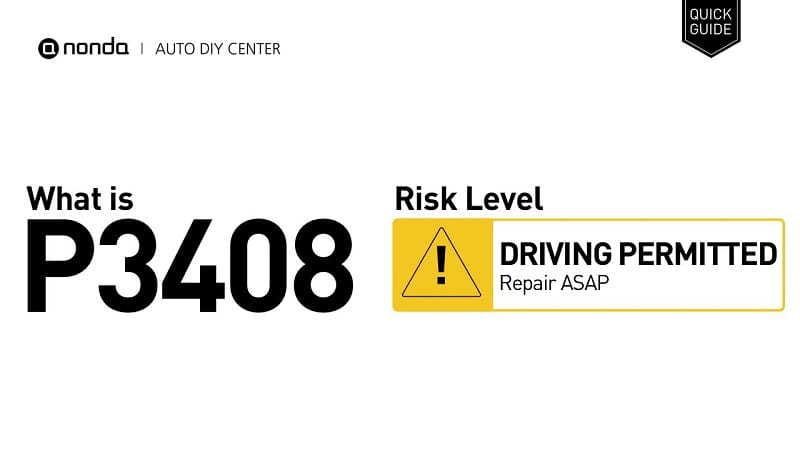This post contains affiliate links. This means I will make a commission at no extra cost to you should you click through and make a purchase [ “As an Amazon Associate, I earn from qualifying purchases.” ]. Read the full disclosure here.
Understanding DTC P3408: Cylinder 1 Exhaust Valve Control Circuit High GuideMechanic.Com Modern engines rely on sophisticated electronic systems to control performance, fuel efficiency, and emissions.
When something goes wrong, the Engine Control Module (ECM) or Powertrain Control Module (PCM) logs a Diagnostic Trouble Code (DTC). One such code is P3408: Cylinder 1 Exhaust Valve Control Circuit High.
This article will explain what P3408 means, the role of the exhaust valve control system, the symptoms and causes of the code, how to diagnose and fix it, and how to prevent it in the future.
See Also: P3409 Cylinder 2 Deactivation/Intake Valve Control Circuit/Open
P3408 Cylinder 1 Exhaust Valve Control Circuit High
What Is DTC P3408?

The P3408 trouble code indicates that the ECM or PCM has detected a high voltage condition in the exhaust valve control circuit for cylinder 1.
This code is commonly found in vehicles equipped with Active Fuel Management (AFM) or Variable Valve Timing (VVT) systems, such as those produced by General Motors (GM).
In engines with AFM, certain cylinders can be deactivated under light load to improve fuel economy. This is done by electronically controlling special valve lifters using oil pressure and solenoids.
If the ECM detects that the voltage in the solenoid control circuit is above the expected threshold, it will set the P3408 code.
This “high” voltage usually means there is an open circuit, short to power, or internal fault causing the control circuit to receive more voltage than it should.
How the Exhaust Valve Control System Works
In AFM or VVT systems, the ECM activates solenoids that control oil flow to specialized hydraulic lifters. These lifters can collapse, preventing the valves from opening — effectively deactivating the cylinder.
In the case of cylinder 1, the exhaust valve solenoid controls whether exhaust gases are allowed to exit or are restricted, depending on the operating mode (V8 or V4).
If the solenoid is not functioning correctly due to electrical or mechanical issues, the ECM may not be able to manage cylinder deactivation, triggering fault codes such as P3408.
P3408 Cylinder 1 Exhaust Valve Control Circuit High
Symptoms of P3408

When P3408 is active, you may experience a range of symptoms, depending on the severity of the issue:
- Illuminated Check Engine Light (CEL)
- Rough idle
- Misfires or hesitation during acceleration
- Poor fuel economy
- Reduced engine performance
- Noise from the engine (ticking or tapping)
- Inability to enter AFM/V4 mode
In some cases, especially if only the circuit voltage is high without mechanical failure, the engine may appear to run normally but with reduced efficiency.
Common Causes of P3408
There are several potential reasons for a high voltage signal in the Cylinder 1 exhaust valve control circuit:
Open Circuit in the Wiring:
A broken wire can cause voltage to build up without reaching the solenoid, resulting in a high voltage condition.
Short to Power:
If the control wire is shorted to a 12V power source, it can send too much voltage to the ECM or solenoid.
Faulty Exhaust Valve Control Solenoid:
An internally damaged or shorted solenoid can lead to abnormal voltage readings.
Bad Electrical Connectors:
Corrosion, moisture, or loose pins in the solenoid’s connector can disrupt normal voltage regulation.
Faulty ECM/PCM:
While rare, a failing control module can send or interpret incorrect voltage signals.
Improper Ground:
A poor ground connection can cause voltage spikes or circuit instability.
P3408 Cylinder 1 Exhaust Valve Control Circuit High
Diagnosing Code P3408
Diagnosing this code correctly is essential to avoid unnecessary part replacement. Here’s how a professional technician might approach it:
1. Scan for Codes
Use an OBD-II scanner to confirm the P3408 code and check for related codes like P3400, P3407, P3411, or cylinder misfire codes (e.g., P0301 for cylinder 1).
2. Visual Inspection
Check the wiring harness and connectors around the AFM solenoids, especially those associated with cylinder 1. Look for:
- Damaged insulation
- Corroded or loose connectors
- Pinched or melted wires
3. Test the Solenoid
Disconnect the cylinder 1 exhaust valve control solenoid and use a multimeter to measure resistance across the terminals. Compare the reading with the manufacturer’s specifications.
You can also use a scan tool with bi-directional control to activate the solenoid and check for proper response.
4. Check for Voltage and Ground
With the ignition on, back-probe the solenoid connector to verify that voltage and ground are present and stable. If voltage is too high (e.g., consistently over 12V), there may be a short to power.
5. Continuity Testing
Use a multimeter to test continuity between the PCM and solenoid terminals. An open or high resistance reading suggests a break or corrosion in the wiring.
P3408 Cylinder 1 Exhaust Valve Control Circuit High
How to Fix P3408

After proper diagnosis, the following repairs can resolve the P3408 code:
- Replace the Exhaust Valve Control Solenoid for Cylinder 1
- Repair or replace damaged wiring or connectors
- Secure or replace faulty ground connections
- Correct shorts to power (if present)
- Clean or replace dirty or corroded electrical terminals
- Update or reprogram the PCM (if software-related)
- Replace the PCM (in rare cases)
After repairs, clear the code using a scan tool and test-drive the vehicle to ensure the code does not return.
P3408 Cylinder 1 Exhaust Valve Control Circuit High
Vehicles Commonly Affected by P3408
This DTC is most commonly reported in General Motors vehicles with AFM engines, including:
- Chevrolet Silverado
- GMC Sierra
- Chevrolet Tahoe
- GMC Yukon
- Chevrolet Suburban
- Cadillac Escalade
These vehicles often use 5.3L or 6.0L V8 engines with AFM technology, which heavily depends on precise solenoid and oil pressure control for proper cylinder deactivation.
How to Prevent P3408
While some electrical failures are unpredictable, many can be prevented with good maintenance habits:
Use the correct engine oil and viscosity.
AFM systems rely on clean, properly pressurized oil.
Change oil and filters regularly.
Dirty oil can clog lifters and solenoids, leading to electrical and mechanical faults.
Inspect wiring regularly.
Especially in high-temperature areas like the engine bay, wires and connectors can degrade over time.
Address check engine lights promptly.
Ignoring early warning signs can lead to more expensive repairs down the line.
Conclusion
The P3408 code — “Cylinder 1 Exhaust Valve Control Circuit High” — signals a high voltage issue in the solenoid or wiring controlling the exhaust valve of cylinder 1. While it may seem like a minor electrical issue, it can lead to significant performance loss if left unaddressed.
By understanding the causes and following a systematic diagnostic approach, the problem can be pinpointed and repaired efficiently. Regular maintenance and oil care are key to preventing this and similar codes in the future.
- 4×4 Truck for Sale Used - October 21, 2025
- 4×4 Truck for Sale Under 20K - October 15, 2025
- 4×4 Truck for Sale QLD - October 12, 2025
